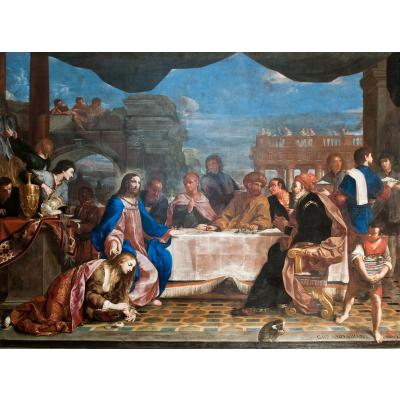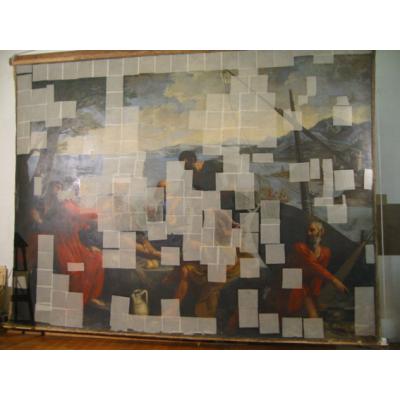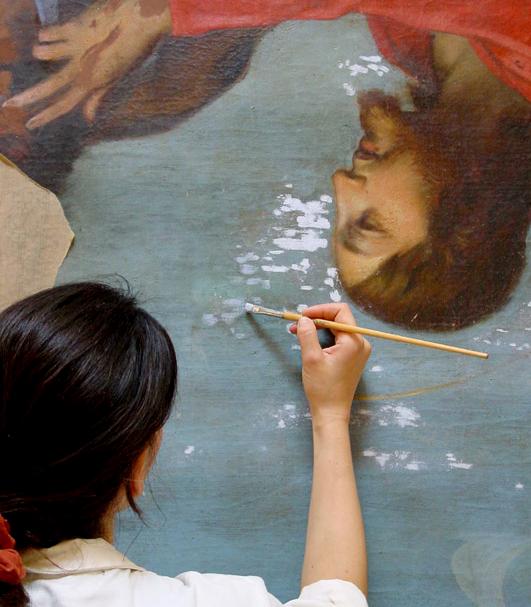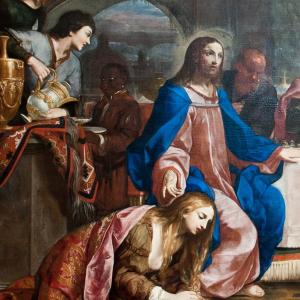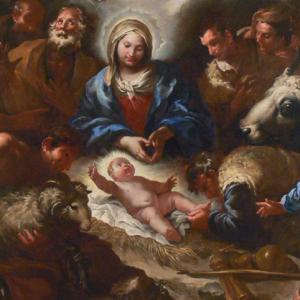Schede
In April, 2007 the total recovery was completed of eleven large paintings on the walls of the Church of San Girolamo della Certosa, in Bologna, portraying significant episodes of the life of Jesus Christ. The oil canvases can be dated between the final years of the 16th century and 1658. Such an extraordinary set of works proves that the most relevant Bolognese artists of the time were actually in town in the above-mentioned period and it also represents the only appreciable series of 16th century Bolognese paintings that have actually remained in the place for which they had been produced.
The three first canvases (585 x 247 cm each) were painted by Bartolomeo Cesi for the high altar towards the end of the Cinquecento while the other eight works (appr. 450 x 350 and 500 x 350 cm each), had been commissioned between 1644 and 1658 to Giovan Andrea Sirani and his daughter Elisabetta, Francesco Gessi, Giovanni Maria Galli known as Bibiena, Lorenzo Pasinelli, Domenico Maria Canuti and to the Neapolitan artist Nunzio Rossi.
Of the whole cycle, only Nunzio Rossi’s Nativity was removed from the church. In the early 19th century it was transferred to an adjoining room, with no windowpanes and doors, and was thus exposed for two centuries to the action of atmospheric agents. Once its restoration was completed, it was unfeasible to re-position it in the same room, or to move it again to the church as a big organ had been assembled in its place. The artwork was therefore put on display in the Bologna City Hall in order to ensure adequate fruition and preservation.
The whole set is a basic element for a better knowledge of Baroque painting, that at the time, it must be kept in mind, had found in Bologna a most innovative and fruitful center. In the 17th century the Church of San Girolamo, whose construction had begun in 1334, was a sort of ‘shrine’ for Bolognese painting. In fact, in addition to the above-mentioned artists it still hosted outstanding masterpieces by Agostino and Ludovico Carracci and by the Guercino, that, in Napoleon’s times, were transferred to the city National Gallery. The church was extremely rich in artworks and historical chronicles mention that “ … the wealth and exquisite style of the paintings [make this church] the Queen of all the churches that can now be admired in this Christian Republic”. The artists summoned to realize the paintings were well aware of this. The ample horizontal shape of the whole structure warranted great compositional liberty and freed them from the limitations imposed by the classical vertical pattern for the altarpiece. Artists such as Gessi requested a very low fee just to be appointed to the task: for his two canvases, he is said to have asked less than half the amount the Guercino obtained for just one altarpiece depicting San Bruno’s Vision. Each painting covers one single seamless canvas. The canvases had been woven on extremely big looms. Most likely the then Prior Canonico Granchio had ordered a large quantity of such material directly from the factory in order to deliver it to the various artists in charge of the wide-ranging decorative cycle that he had planned for the church as a whole, which also fits in with the works that Bartolomeo Cesi had previously painted. Thanks to a multi-year project involving cataloguing, analysis of deterioration and restoration, the recovery of this important unitary set of paintings was finally completed. Such works definitely represent the most significant visual and artistic item for visitors to the church, but they are also part of a wider set of artworks. The recovery of the picture series thus pertains to a wider design to enhance the church building as a whole, which in turn is included in the recovery plans concerning the monumental cemetery inside which the church itself is located. The restoration of other important paintings inside the church is also targeted at the same purpose. In 2005 four canvases by Francesco Gessi were restored, each portraying a Carthusian monk. The following are currently being restored: a late 16th century Annunciation of the Bolognese school; a 15th century polychromatic relief of the Nativity of the Donatello school, and lastly a mid-16th century polychromatic lectern. These three final items are now under study by the Bologna City Council and by the Ministry of the Italian Cultural Heritage and are considered as remarkable discoveries for the art history of the region.
The restoration works of the Christological cycle of paintings were made possible by the joint efforts of the Comune di Bologna, the Soprintendenza per il Patrimonio Storico Artistico e Etnoantropologico for the districts of Bologna, Ferrara, Forlì, Ravenna and Rimini, the Fondazione del Monte di Bologna, UNICREDIT Banca, the Order of Passionists and HERA-Funerary Services. Teachers and students from the University of Bologna frequently choose the Certosa of Bologna for their studies, i.e. practice, graduation dissertations, postgraduate courses. From 2003 onwards, the involved organizations also funded and supervised the reconstruction of the electrical, alarm and lighting systems of the church, in order to grant adequate safeguard, preservation and fruition of the paintings. At the completion of restoration works and modernization of technical facilities, several promotional and communication activities were carried out, such as publications, concerts, exhibitions, and guided tours. Finally, the upgrading program also included the re-plastering and paintworks in the 15th century Cloister onto which the Church of San Girolamo looks.




